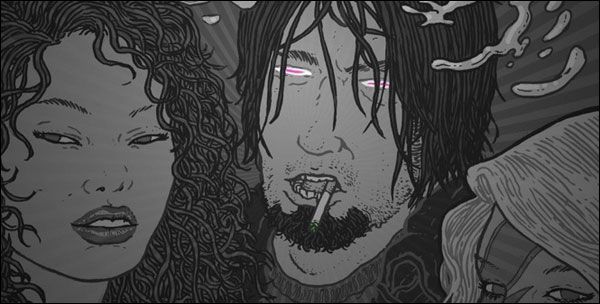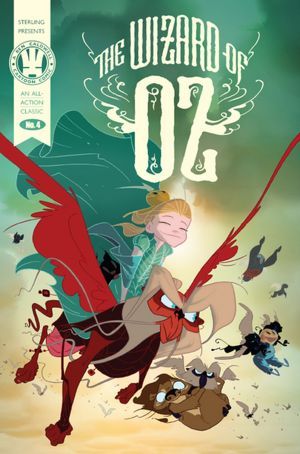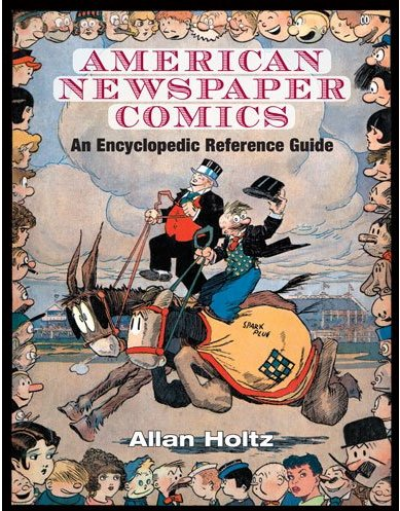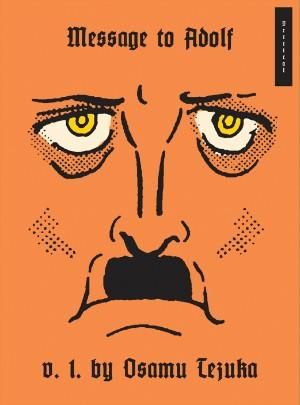Hello and welcome to What Are You Reading? Our guest this week is writer and letterer Ed Brisson, whose comic Comeback with artist Michael Walsh arrives in November. He's also the writer of Murder Book and Black River.
To see what Ed and the Robot 6 crew have been reading, click below.
*****
Michael May
All-Action Classics, Volume 4: The Wizard of Oz: It’s no secret that I’m a big fan of Ben Caldwell’s work, and that’s not changing with the latest installment in his All-Action Classics line. Like the other entries in the series, Caldwell takes some liberties with the classic story he's adapting in order to make it funnier and faster-paced, but he doesn't betray its heart. I can't do without the super faithful Oz adaptations that Eric Shanower and Skottie Young have been doing for Marvel, but we don’t need another one of those. I wouldn’t want fidelity to Baum’s novel at the expense of things like the Scarecrow’s emphasizing that he wants his new brain to be "squishy." Caldwell's faithful to the spirit of Wizard of Oz (much more so than the classic movie, in fact), but he puts his own creative mark on it, and that's a wonderful thing, too.
The King #1: Thomas Hall and Daniel Bradford are the guys behind Robot 13 and as much as I liked that comic, The King is even better. It’s about a former wrestler/Elvis impersonator who kills monsters for money. Hall and Bradford pit him against even weirder, more imaginative creatures than the ones they came up with for Robot 13 (in the first issue our “hero” is hired by a human heart with mechanical legs to destroy a giant monster with killer nipples). They substitute Robot 13’s ongoing mystery for extra humor and end up with a comic that’s a lot of fun. I’m looking forward to trying the second issue.
Model A: I love wordless stories and Jef Bambas’ about a recently self-aware robot is an excellent one. Bambas communicates everything he needs to through the robot’s body language and creates a charmingly clumsy character with more personality than Wall-E. I’ve only read the first issue (there are two as I write this), but I want to keep going and watch the nameless robot figure out where he is and why he was created.
The Extraordinary Adventures of Adele Blanc-Sec: I’ve been looking forward to this for a long time. I love Jacques Tardi’s art almost as much as I love the idea of a woman fighting pterodactyls and Assyrian demons in early-1900s Paris. Sadly, the satirical aspects of the book disappointed me. Tardi is making fun of a certain kind of adventure story with relentlessly dense, expository dialogue and ridiculous plot twists that come out of nowhere. Unfortunately, he’s too good at mimicking what he’s mocking and the story is mostly unreadable. It sure is amazing to look at though. Tardi’s art pulled me right into the world, even though I was skimming past word balloons while I was there.
Tom Bondurant
Thanks to the good folks at the University of Michigan Press, I got to check out American Newspaper Comics: An Encyclopedic Reference Guide, by Allan Holtz. Basically it is a big book of lists, augmented with a wide-ranging (but not comprehensive) disc with PDF examples of selected comics. The author runs a blog, and the book occasionally directs researchers there. Therefore, the book is pretty much what its title suggests, and not a lot more. I was expecting something like Maurice Horn's venerable World Encyclopedia of Comics, with actual descriptions of what the strip was about, maybe some critical appraisals, and artwork, but that's not this book. Instead, an entry's length depends on the amount of raw data it generates, such that the more creative teams and/or titled storylines gets more coverage. This means that Peanuts and Calvin and Hobbes get the minimum, The Phantom's entry takes up about four pages, and Donald Duck gets a page and a half. The book is therefore not for the more casual newspaper-strip fan, and the disc (which only includes one example per comic) is only marginally more helpful. All that said, though, Holtz has clearly made every effort to be as complete as possible. His guide should be an excellent starting point for any semi-serious student of the subject.
Before hitting the road this week, I was glad to see the final "Knightfall" collection hit comics shops. Volume 3 collects "KnightsEnd" and "Prodigal," the stories which showed Bruce Wayne taking back the Batman identity before (temporarily) handing it off to Dick Grayson. It's by the regular '90s Bat-crew of writers Doug Moench, Chuck Dixon and Alan Grant, and pencillers Mike Manley, Bret Blevins and Graham Nolan, with occasional help from Jo Duffy, Jim Balent, Mike Gustovich, and Phil Jiminez. Of course I read these stories 18 (gulp!) years ago, but it was nice to revisit them in such well-packaged chunks. "KnightsEnd" especially struck me this time as a clear parallel to "Knightfall." Where Bruce spends the latter getting worn down by Gotham's worst before Bane finishes him off, here he must run a gauntlet of deadly martial artists before facing Jean-Paul. In "Knightfall" he kept convincing himself he could go on, but here he has a better awareness of how ready he is. Most pointedly, though, the final Batman/Azrael confrontation begins exactly the way Batman/Bane did -- except this time, Graham Nolan gives Batman the same pose he gave Bane, challenging his foe at the entrance to the Batcave. These stories have held up better than I expected, and they weren't bad to begin with.
Mark Kardwell
This week I caught up with a few of my favorite webcomics, like Warren Pleece's Alby Figgs. I always hear Paul Whitehouse's voice in my head as I read Alby's deluded monologues. A sketch David Wynne posted on Twitter the other day sent me back to his Particle Fiction website to see how many of his Ideasman strips are still posted there. It's like Warren Ellis and Paul Grist collaborating on a Green Lantern reboot for the kids, as great as that sounds. Jamie Smart updated Corporate Skull a few days ago, reminding me of its crazybonkersness. Everyday my email inbox contains a new panel or two of Craig Conlan's Super Quest Friends Forever, which is always a joy. And it's impossible not to be impressed by both John Allison's craft and work-rate. It always seems like there's new work up at his site everyday, and it never fails to charm and amuse.
Brigid Alverson
Vertical's new edition of Osamu Tezuka's Message to Adolf is a striking-looking book: The front cover is a full-face picture of Hitler himself, looking rather bemused. The story inside is set during the rise of the Third Reich and starts with the murder of a Japanese student in Berlin during the 1936 Olympics. His older brother, a reporter, is in town to cover the Olympics, and when he tries to investigate, things get weird in a hurry. His brother's body disappears, and all traces of his existence are swept away; meanwhile, there seems to be a tie-in with the murder of a geisha in Japan. The story also involves, rather improbably, two German youths living in Japan, one a Jew, one from a Nazi family, both named Adolf. Viz published this series as five volumes back in the 1990s, under the title Adolf; Vertical is releasing it as two oversized omnibus volumes, and like the Viz edition, it is flipped to read left to right. Tezuka's artwork is amazing, and this story is one of the best of his I have read so far.
Madeleine Rosca's The Clockwork Sky is a fanciful steampunk story set in London in an alternative 1895, when all the riffraff have been replaced by steam-driven robots. As in her earlier trilogy, Hollow Fields, the heroine is a spunky, smart girl; this time it's Sally Pepper, the niece of the inventor and manufacturer of the robots, who has inherited her uncle's knack for mechanical things. When Sally busts out of her uncle's home on a borrowed velocipede, he sics Sky, a police robot, on her, but the two of them end up teaming up to investigate a rash of missing children. Rosca's manga-influenced style works well with the subject matter, and like her earlier trilogy, Hollow Fields, this book is a delight for the eye, but at 150 pages, this volume is awfully slim for its $10.99 price tag.
Ed Brisson
I've just finished burning my way through the first three BPRD: Hell on Earth trades. I'm one of the very few who couldn't get into Hellboy, but I've been loving the crap out of BPRD. Aside from great writing, I'm really loving the artists that they've been bringing in. James Harren, Guy Davis, Tyler Crook...drool, drool, drool! Everything about this series is great. I've got BPRD: Hollow Earth sitting on my nightstand, and then going to head back and start at the very first BPRD trade. After that, I may even give Hellboy another shot.
In line with “things everyone likes that I just don't seem to dig” is Akira. Not crazy about the film, which made me a little hesitant about giving the original manga series a go. Luckily, my friend (and sometime collaborator) Johnnie Christmas forced the first three phone-book-sized trades into my drunken hands last week. Devoured the first in one sitting and am enjoying the ever-loving hell out of the series. I'm just on the second trade, but I really love how the book is taking its time to tell the story. I'm even toying with the idea of going back and rewatching the movie.
I was at Fan Expo Canada a couple weeks ago and picked up LP written by Curt Pires and illustrated by Ramon Villalobos. Curt is part of that whole Calgary comic scene that includes other dudes like Ryan Ferrier (Tiger Lawyer, Brothers James), Riley Rossmo (Debris, Green Wake) and others. There's a lot of cool comic stuff going on in that city! LP is a one shot comic about a mystical record, that has a ton of drugs, rock n roll and gangsters. It's got a sort of Jodorowsky/Pope sensibility to it that really plays into my own interests. Curt and Ramon prove that they're both talents to keep an eye on. You can find it online at: http://curtpires.bigcartel.com/product/lp. Highly recommended. Support indies!
Hawkeye! I hope that everyone is reading this. Typically, I'm not much of a superhero reader. When I do, I stick to the street level stuff (Daredevil, Punisher, etc). So, it's a miracle that Fraction and Aja have taken a character that I couldn't have cared less about and hooked me in pretty hard. Part of it may be that in taking Hawkeye on these solo adventures, they've grounded him a little more. No crazy eight-page fight scenes in space. Lots of little bits of real life business. There's nothing about this series I don't love. The art is, of course, spectacular. The muted and flat colour selection is amazing. The writing is top notch. I love getting this glimpse of Hawkeye in these smaller, done-in-one style stories. I love the way that Aja is laying out the pages. In particular, there are a couple pages in the second issue where Kate and Clint are talking on the phone and there are something like 20 postage stamp sized panels per page. Just writing this paragraph about it makes me want to go back and reread it. It's one of the few comics I bought digitally, then again at my LCS so that I could keep copies next to my computer for inspiration while writing. I hope this thing goes on forever.





